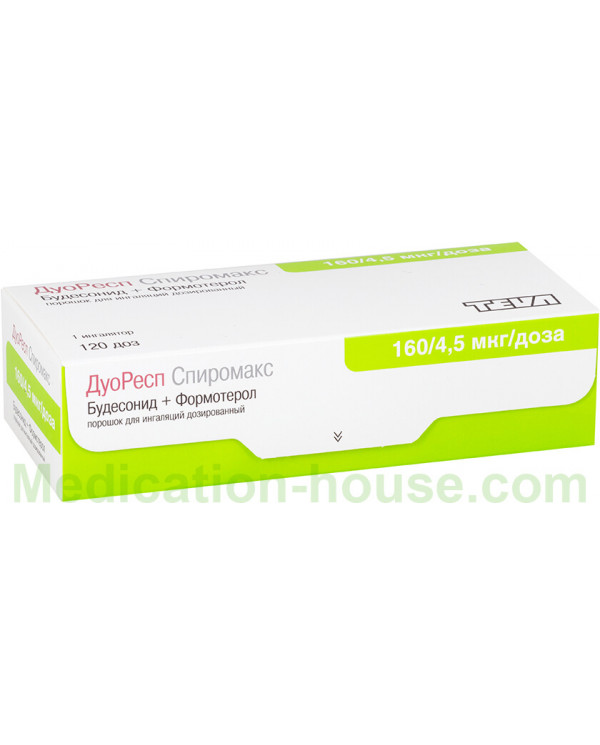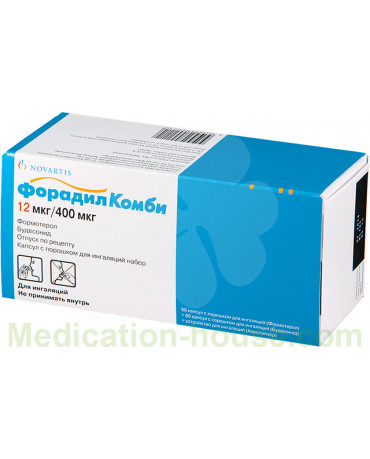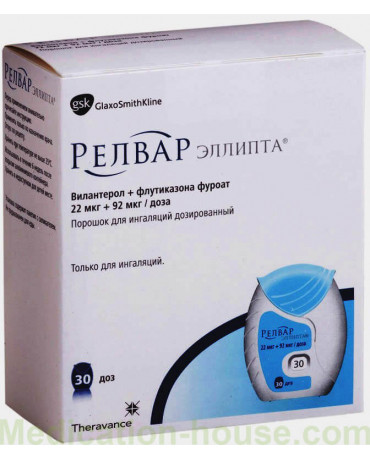DuoResp Spiromax instruction
You can buy DuoResp Spiromax here
DuoResp Spiromax is a combined preparation with bronchodilating, glucocorticoid, beta2-adrenomimetic action.
Release form and composition
Dosage form of DuoResp Spiromax release - metered-dose powder for inhalation: almost white or white, with no visible inclusions / lumps; placed in a multi-dose powder inhaler having a red translucent cap for the mouthpiece; the inhaler should not have visible damage; the dosing indicator window for 160 / 4.5 μg / dose should show N 120, 320/9 μg / dose - N 60 (in plastic inhalers placed in foil, in a cardboard pack of 1 or 3 inhalers).
Active substances as part of 1 delivered dose:
micronized budesonide - 0.16 or 0.32 mg;
micronized formoterol fumarate dihydrate - 0.0045 or 0.009 mg.
Auxiliary component: lactose monohydrate - 5 or 10 mg (approximately).
Pharmacodynamics
DuoResp Spiromax is a combination bronchodilating drug. Its active components - formoterol and budesonide - have different mechanisms of action and exhibit an additive effect in reducing the frequency of exacerbations of bronchial asthma and COPD (chronic obstructive pulmonary disease).
The special properties of the components allow their combined use to stop attacks and as a supportive therapy, or as a supportive therapy for bronchial asthma.
Properties of the active substances DuoResp Spiromax:
budesonide: it is a glucocorticosteroid that, after inhalation, has a dose-dependent and rapid (usually within a few hours) anti-inflammatory effect on the respiratory tract, which helps to reduce the severity of symptoms and the frequency of exacerbations of bronchial asthma. With inhalation, there is a decrease in the incidence of serious undesirable effects more than when using drugs with a systemic effect. It reduces the production of mucus, the severity of edema of the bronchial mucosa, hyperreactivity and the formation of sputum of the respiratory tract. The exact mechanism of the anti-inflammatory action of budesonide is unknown;
formoterol: is a selective β2-adrenergic receptor agonist. After inhalation, it causes prolonged and rapid relaxation of the smooth muscles of the bronchi in patients with reversible airway obstruction. A dose-dependent bronchodilator action develops rapidly (usually from 1 to 3 minutes after use) and persists for at least 12 hours after taking a single dose.
DuoResp Spiromax in the treatment of bronchial asthma can reduce the severity of the symptoms of the disease, reduces the frequency of its exacerbations and improves bronchial function. The drug has good tolerance.
In severe COPD with DuoResp Spiromax, a significant decrease in the frequency of exacerbations of the disease is observed.
Pharmacokinetics
absorption: DuoResp Spiromax is bioequivalent to the corresponding single drugs with respect to the systemic action of formoterol and budesonide. However, after the use of the drug, there was a slight increase in the suppression of cortisol in comparison with single drugs (it does not affect clinical safety). When used in the composition of the combined drug AUC, budesonide is slightly higher, the Cmax value in the blood plasma of the drug is higher and absorption is faster. For formoterol when administered as part of DuoResp Spiromax, Cmax in blood plasma is the same as for a single drug. Inhaled budesonide is rapidly absorbed and reaches plasma Cmax 30 minutes after inhalation. The average dose of budesonide in the lungs varies from 32% to 44% of the delivered dose, and systemic bioavailability is approximately 49%. Inhaled formoterol is rapidly absorbed and 10 minutes after inhalation reaches Cmax in blood plasma. The average dose of formoterol in the lungs is from 28% to 49% of the delivered dose, systemic bioavailability is about 61%;
distribution: binding to plasma proteins of budesonide is 90%, formoterol - 50%. Vd of budesonide is about 3 l / kg, formoterol - 4 l / kg;
metabolism and excretion: about 90% of budesonide undergoes intensive biotransformation during the "first passage" through the liver with the formation of metabolites that have low glucocorticoid activity. The glucocorticoid activity of the main metabolites of 16-α-hydroxyprednisolone and 6-β-hydroxybudesonide does not exceed 1% of the corresponding activity of budesonide. Formoterol is inactivated by conjugation with the formation of active O-demethylated metabolites, mainly as inactivated conjugates. There is no evidence of a metabolite interaction or substitution reaction between formoterol and budesonide. Budesonide is predominantly metabolized with the participation of the enzyme CYP3A4. Its metabolites unchanged or as conjugates are excreted in the urine. Unchanged budesonide in urine is found only in a small amount. Systemic clearance of budesonide is high (approximately 1.2 L / min). Formoterol is mainly metabolized in the liver, after which it is excreted by the kidneys. 8–13% of the delivered dose of formoterol after inhalation is excreted unchanged in the urine. Systemic clearance of formoterol is high (approximately 1.4 l / min). The elimination half-life averages 17 hours.
In patients with liver diseases, the plasma concentration of the active components of DuoResp Spiromax in the blood may increase.
Indications for use
bronchial asthma, which is not amenable to sufficient control by the administration of inhaled corticosteroids and short-acting beta2-adrenostimulants or is adequately controlled by inhaled corticosteroids and long-acting beta2-adrenostimulants;
COPD - for symptomatic treatment in severe illness (FEV1 <50% of the estimated estimated level) and the presence of recurring exacerbations in the anamnesis, which have pronounced symptoms of the disease, despite the use of long-acting bronchodilators.
Contraindications
Absolute:
age up to 18 years;
individual intolerance to the components of the drug, as well as inhaled lactose.
Relative (diseases / conditions in which the use of DuoResp Spiromax requires caution):
lactose intolerance, glucose-galactose malabsorption or lactase deficiency;
severe arterial hypertension;
an aneurysm of any localization or other cardiovascular diseases in a severe course (tachyarrhythmia, coronary heart disease or severe heart failure);
pulmonary tuberculosis in active / inactive form;
uncontrolled hypokalemia;
respiratory infections of fungal, viral or bacterial etiology;
pheochromocytoma;
thyrotoxicosis;
diabetes;
lengthening of the QT interval (associated with the likelihood of developing an extension of the QTc interval with the use of formoterol);
idiopathic hypertrophic subaortic stenosis;
period of pregnancy and breastfeeding.
Instructions for use DuoResp Spiromax: method and dosage
DuoResp Spiromax is a breath-activated drug, which means the active components enter the respiratory tract when the patient inhales it from the mouthpiece.
In moderate to severe asthma, patients are able to develop a sufficient inspiratory flow rate that provides a therapeutic dose of the drug.
Before use, open the mouthpiece cover (unscrew it down until it clicks and it opens). Then the mouthpiece must be placed between the teeth, closing his lips around it. Do not bite the mouthpiece. After that, take a deep breath from the dispenser. After removing the mouthpiece from the mouth, you need to hold your breath for 10 seconds or longer (as far as the patient is comfortable). Then carefully exhale the air.
Shake the inhaler before use. Also, do not exhale into the mouthpiece and hold your breath in preparation for inhalation.
After inhalation, the mouth must be rinsed with water.
When using DuoResp Spiromax, a specific taste sensation is possible (associated with an auxiliary component - lactose).
Bronchial asthma
For the initial treatment of bronchial asthma, intermittent and mild persistent course DuoResp Spiromax is not intended.
The dose should be selected individually based on the severity of the disease (it is important to consider not only at the beginning of therapy, but also when adjusting the maintenance dose). If the use of other doses than in the composition of DuoResp Spiromax is indicated, it is necessary to use the active components in separate inhalers.
To control the optimal dose of the drug, patients need to visit a doctor regularly. The dose should be the lowest at which optimal control of the symptoms of the disease is maintained. After achieving optimal control when using the drug 2 times a day, it is recommended that the dose be titrated to the minimum effective dose, up to the use of DuoResp Spiromax 1 time per day, in cases where the patient needs maintenance therapy in combination with a long-acting bronchodilator.
160 / 4.5 mcg / dose - maintenance therapy
DuoResp Spiromax is prescribed 2 times a day for 1-2 inhalations. If necessary, a single dose can be increased to 4 inhalations. In order to stop attacks, the patient should always have a separate inhaler with a short-acting beta2-adrenostimulator. An increase in its frequency of use is an indicator of a deterioration in overall control of the disease (a review of anti-asthma therapy is required).
160 / 4.5 mcg / dose - maintenance therapy and relief of seizures
DuoResp Spiromax can be prescribed as continuous maintenance therapy or as therapy on demand in cases of seizures. The drug is especially indicated with insufficient control over the disease and the need for frequent use of drugs to relieve seizures, as well as with a burdened history of exacerbations of bronchial asthma, which required medical intervention.
When using a large number of inhalations for stopping attacks, the condition of patients needs to be carefully monitored, given the likelihood of dose-dependent adverse reactions.
Recommended use of DuoResp Spiromax: 1 time per day (morning or evening), 2 inhalations or 1 inhalation in the morning and evening. In some cases, a maintenance dose may be prescribed - 2 times a day for 2 inhalations. With the development of symptoms, 1 additional inhalation is required. If within a few minutes a further increase in symptoms is observed, 1 additional inhalation may be required (maximum for relief of 1 attack - 6 inhalations).
The average daily dose is 8 inhalations, sometimes for a short time it may increase to 12 inhalations (therapy may need to be reviewed).
COPD
Recommended single dose of DuoResp Spiromax (frequency of use - 2 times a day):
160 / 4.5 mcg / dose: 2 inhalations;
320/9 mcg / dose: 1 inhalation.
Side effects
An increase in the incidence of side effects associated with the combined use of budesonide and fenoterol is not observed.
The most common disorders include the pharmacologically expected side effects of beta2-adrenergic agonists, including heart palpitations and tremors. As a rule, the symptoms are of moderate severity and disappear a few days after the start of treatment.
Possible violations (> 10% - very often;> 1% and <10% - often;> 0.1% and <1% - infrequently;> 0.01% and <0.1% - rarely; <0.01 % - rarely):
respiratory system: often - hoarseness, candidiasis of the mucous membrane of the pharynx and oral cavity, cough, irritation of the pharynx; rarely - bronchospasm; very rarely - paradoxical bronchospasm;
cardiovascular system: often - palpitations; infrequently - tachycardia; rarely - arrhythmia, including atrial fibrillation, extrasystole, supraventricular tachycardia; very rarely - lengthening of the QT interval, angina pectoris, fluctuations in blood pressure;
musculoskeletal system: infrequently - muscle cramps;
digestive system: infrequently - nausea;
immune system: rarely - delayed / immediate type hypersensitivity reactions, including exanthema, urticaria, pruritus, anaphylactic reactions, dermatitis, angioedema;
endocrine system: very rarely - Cushing's syndrome, growth retardation, adrenal suppression, lower bone mineral density;
nervous system: often - tremor, headache; infrequently - dizziness; very rarely - a violation of taste;
organ of vision: very rarely - glaucoma, cataract;
psyche: infrequently - sleep disturbances, psychomotor agitation, agitation, anxiety; very rarely - behavior disorders, depression;
skin / subcutaneous tissue: infrequently - bruising;
metabolism: rarely - hypokalemia; very rarely - signs of systemic glucocorticoid effects, including adrenal hypofunction, hypoglycemia.
Long-term use of high doses of inhaled GCS can lead to a systemic effect, the use of beta2-adrenostimulants can lead to an increase in blood levels of free fatty acids, insulin, ketone derivatives and glycerol.
Overdose
The main symptoms are:
formoterol: palpitations, headache, tremor; in some cases, tachycardia, hyperglycemia, hypokalemia, lengthening of the QTc interval, arrhythmia, nausea and vomiting;
budesonide: acute overdose - no clinically significant effects are expected; chronic use of excessive doses is a systemic effect of GCS in the form of hypercorticism and suppression of adrenal function.
In cases of overdose, symptomatic / supportive treatment should be given. If, due to an overdose of formoterol, DuoResp Spiromax is canceled, the appointment of the appropriate GCS is usually considered.
In acute bronchial obstruction, the use of formoterol in a dose of 90 mcg for 3 hours is safe.
special instructions
The cancellation of DuoResp Spiromax should be carried out with a gradual dose reduction. Abrupt withdrawal of therapy is not recommended.
For the initial selection of treatment in the first stages of therapy for bronchial asthma, the drug is not used.
The use of formoterol can lead to a prolongation of the QT interval.
An increase in the frequency of use of bronchodilators as emergency drugs is a sign of a deterioration in the course of the underlying disease and a reason for reviewing treatment tactics. Progressive / unexpected deterioration in the control of symptoms of bronchial asthma or COPD refers to conditions that are potentially life-threatening in nature, which requires urgent medical attention. In such situations, it is necessary to consider the likelihood of increasing the dose of GCS or adding systemic anti-inflammatory therapy, for example, antibiotic treatment in case of infection or a course of oral GCS.
According to the instructions, DuoResp Spiromax should be used regularly even in the absence of symptoms.
It is not recommended to start therapy during an exacerbation or with a significant deterioration in the course of bronchial asthma.
A systemic effect can occur when taking any inhaled GCS, especially with prolonged use of high doses. The development of a systemic effect during inhalation therapy is less likely than when using oral corticosteroids. Possible systemic effects are suppression of adrenal function, decreased bone mineral density, glaucoma and cataracts.
Due to the potential effect on bone mineral density, patients who take high doses of the drug for a long time with the presence of risk factors for osteoporosis need special attention.
As with any other inhalation treatment, a paradoxical bronchospasm may develop with an immediate increase in wheezing after the dose is applied (may require cancellation of DuoResp Spiromax, review of treatment tactics and, if necessary, the appointment of alternative treatment).
Rinsing the mouth with water after inhalation is a preventive measure for the occurrence of candidiasis of the oral mucosa.
If there is reason to believe that against the background of previous systemic therapy for corticosteroids, there were functional disorders of the adrenal gland, precautions should be taken when transferring patients to DuoResp Spiromax treatment.
Patients who in the past received long-term treatment with high doses of inhaled GCS, or who needed urgent intake of high doses of GCS, can also be assigned to this risk group. During periods of stress or surgery, an additional appointment of GCS should be provided.
Precautions must be observed when treating patients with an extended QTc interval (formoterol can lead to an extended QTc interval).
Special precautions should be observed in patients with unstable bronchial asthma who use short-acting bronchodilators to relieve seizures in cases of exacerbation of severe bronchial asthma, since the likelihood of hypokalemia increases with hypoxia and other conditions in which there is an increased risk of hypokalemia. In these cases, it is recommended to monitor the serum potassium content.
In diabetes mellitus, it is necessary to control the concentration of glucose in the blood during the period of therapy.
Influence on the ability to drive vehicles and complex mechanisms
Due to the likelihood of adverse reactions, caution is required when driving vehicles.
Pregnancy and lactation
Features of the use of DuoResp Spiromax in pregnant and lactating women have not been studied.
During pregnancy and breastfeeding, the use of the drug is possible only in cases where the expected benefit exceeds the possible harm. The drug can be prescribed in the minimum effective dose, which is necessary to maintain adequate control of symptoms of bronchial asthma.
Use in childhood
In patients of childhood (under 18 years of age), DuoResp Spiromax is contraindicated.
With impaired renal function
The safety profile in patients with renal failure has not been studied. The active components of DuoResp Spiromax are excreted mainly by the kidneys, with the participation of hepatic metabolism, therefore, with severe liver cirrhosis, a slowdown in its elimination rate can be expected.
With impaired liver function
The safety profile in patients with liver failure has not been studied. The active components of DuoResp Spiromax are excreted mainly by the kidneys, with the participation of hepatic metabolism, therefore, with severe liver cirrhosis, a slowdown in its elimination rate can be expected.
Drug interaction
With the combined use of DuoResp Spiromax with some drugs / substances, the following effects may develop:
general anesthesia with halogenated hydrocarbon preparations: increased risk of arrhythmias;
ketoconazole (at a dose of 200 mg once a day) and other powerful CYP3A4 inhibitors: a significant increase in the plasma concentration of budesonide (it is recommended to avoid combinations; if necessary, the combined use should maximize the interval between their use, a dose reduction of budesonide may also be required);
quinidine, disopyramide, procainamide, phenothiazines, antihistamines (terfenadine), monoamine oxidase inhibitors, tricyclic antidepressants: lengthening the QT interval and increasing the likelihood of ventricular arrhythmias;
formoterol: a decrease in the intensity of its action (the combination is not recommended, except in emergency cases);
alcohol, levothyroxine, levodopa, oxytocin: decreased tolerance of the heart muscle to beta2-adrenergic agonists;
monoamine oxidase inhibitors, as well as drugs with similar properties, including procarbazine and furazolidone: increased blood pressure;
other beta-adrenergic drugs: increased adverse reactions of formoterol; probably the development of hypokalemia, which can be enhanced by concomitant therapy with xanthine derivatives, diuretics, or corticosteroids; hypokalemia can increase the predisposition to arrhythmias in patients receiving cardiac glycosides.
When using DuoResp Spiromax with other drugs used to treat bronchial asthma, the development of interaction is not observed.
Terms and conditions of storage
Store at temperatures up to 25 ° C. Keep out of the reach of children.
Shelf life is 2 years.
After the foil wrapper has been opened, DuoResp Spiromax can be used for 6 months.
Terms of sell
You don't need a prescription to buy DuoResp Spiromax.



